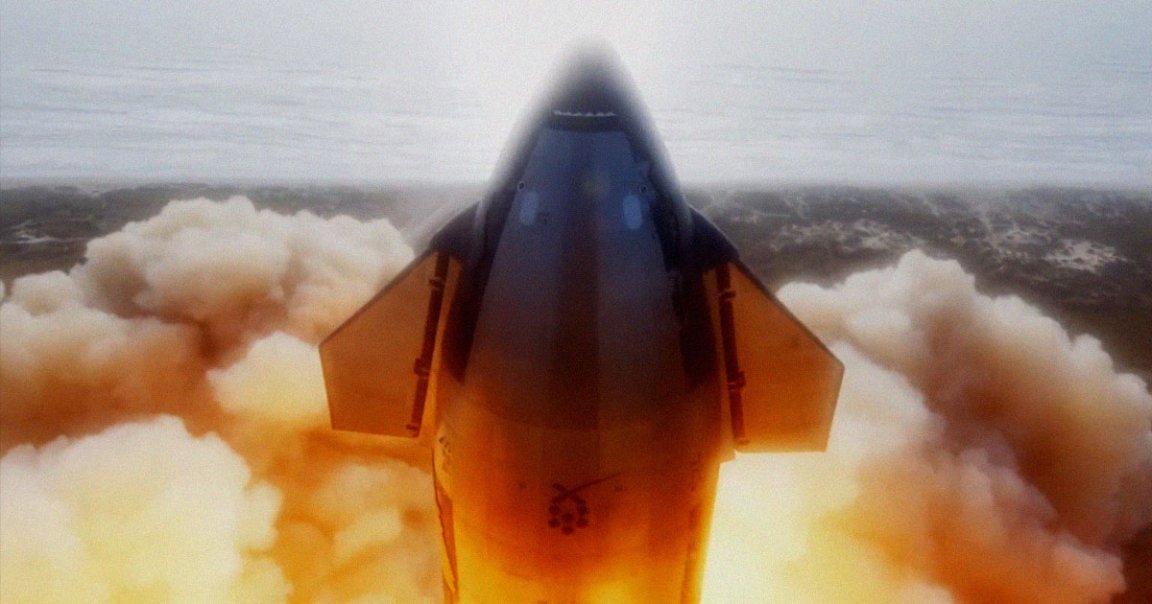
As SpaceX’s Starship took to the skies last week during its inaugural launch, its Super Heavy booster inflicted untold damage to the launch pad below, blasting through layers of concrete and dredging up watery folds of the Earth.
Photos of the aftermath stand as testament to the sheer forces generated by the most powerful rocket ever made — but they may also indicate that SpaceX and its CEO Elon Musk didn’t do their due diligence in preparing the launchpad.
One viral image shows the concrete forming the topmost layer of the launchpad almost completely blown away, leaving behind only a skeleton of deformed rebar. Gaping beneath is a massive crater, where water can be seen flooding its moldering interior.
The saving grace is that despite the massive damage below, the launch tower remains mostly intact.
Overall, it’s more damage than what SpaceX engineers — or at least their CEO — were anticipating.
Leading up to the launch date, Musk shared the mission’s “low” bar for success: “Just don’t blow up the launchpad,” he said in a live Twitter Spaces session, as quoted by Insider.
After Starship’s launch, when it became immediately clear that the launchpad was anything but intact, Musk soon gave his tentative analysis.
“The engines when they throttled up may have shattered the concrete, rather than simply eroding it,” he said in a tweet on Friday.
“We wrongly thought, based on static fire data, that [the concrete] would make it through one launch,” he added.
Ambitiously, the CEO wagered that SpaceX could launch again in one to two months, but some experts have estimated that it will take at least several months or longer.
Given the timelines involved, it could end up being a costly setback for SpaceX, as NASA is hoping to use the Starship launch system during its crewed Artemis 3 mission to the lunar surface as soon as 2025.
It’s got to sting, then, that the massive damage may have been avoided had Musk decided to wait and implement a few precautions that are widely used in other big rocket launches, as some are arguing.
One common solution, as experts have noted, would be a flame diverter or trench of some kind, that redirects the rocket exhaust and its massive acoustic energy away from damaging the vehicle and the launchpad. Ironically, in 2020, Musk tweeted that SpaceX was “aspiring to have no flame diverter,” adding that “this could turn out to be a mistake.”
Another would be a water deluge system, which uses water to dampen heat and acoustic energy — something that SpaceX has been flirting with. According to Musk, SpaceX started building a “massive water-cooled, steel plate to go under the launch mount,” he said in a tweet , but that it “wasn’t ready in time.”
Other heavy lift systems, like NASA’s powerful Space Launch System, and SpaceX’s very own Falcon 9 rocket, use either flame diverters or water deluge systems, according to SpaceFlight Now.
To make matters worse, the blowback from the lack of dampening extended far beyond solely damaging the launchpad. Just ask the residents of a nearby city, who were engulfed by a billowing cloud of dust and grime kicked up by the launch, plus a shattered window for good measure.
The inadequate launchpad could even be responsible for significant damage to Starship itself, as some have theorized, including popular YouTuber and rocket scientist Scott Manley in a recent video.
The unconfirmed theory goes that the concrete and dirt blasted into the air by the powerful rocket may have struck and damaged some of Starship’s engines, which could explain why at least three appeared to have failed just seconds after liftoff, as seen in the live broadcast. This cascaded into what onlookers witnessed and what SpaceX has since confirmed: the expendable Super Heavy booster, short a few engines, failed to separate from the Starship spacecraft and began losing altitude. SpaceX, in turn, ordered the rocket’s self-destruction.
The aerospace company, however, has yet to comment on whether concrete impacts were partially responsible for the engine failure.
Still, despite Starship exploding, the launch has been mostly hailed by experts and fans as a success. Above all, it’s been framed as a necessary “learning experience,” in the words of former NASA official Daniel Dumbacher, speaking to The New York Times.
But on the other hand, it’s fairly standard procedure to include some sort of flame diverter or water deluge system for large rocket launches, Eric Roesch, an environmental compliance and risk assessment expert, told the publication, which makes it all the more puzzling why SpaceX completely forewent including either solutions.
All told, it’s a hard-learned lesson, but the data gathered from the inaugural flight, whether you view it as a success or failure, will undoubtedly prove invaluable for exciting launches in the hopefully near future.
More on SpaceX: Video Shows Falling Starship Debris Smashing a Minivan